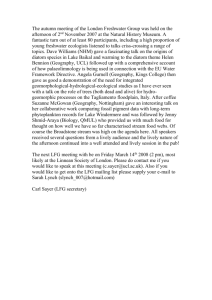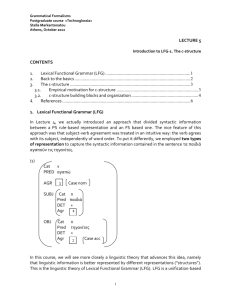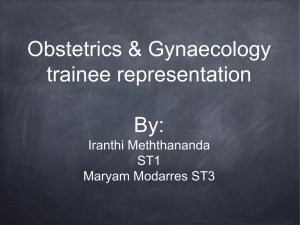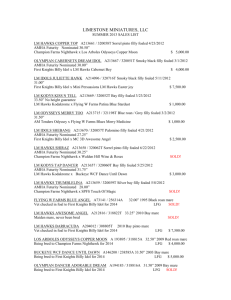White Paper - Cascade Research
advertisement
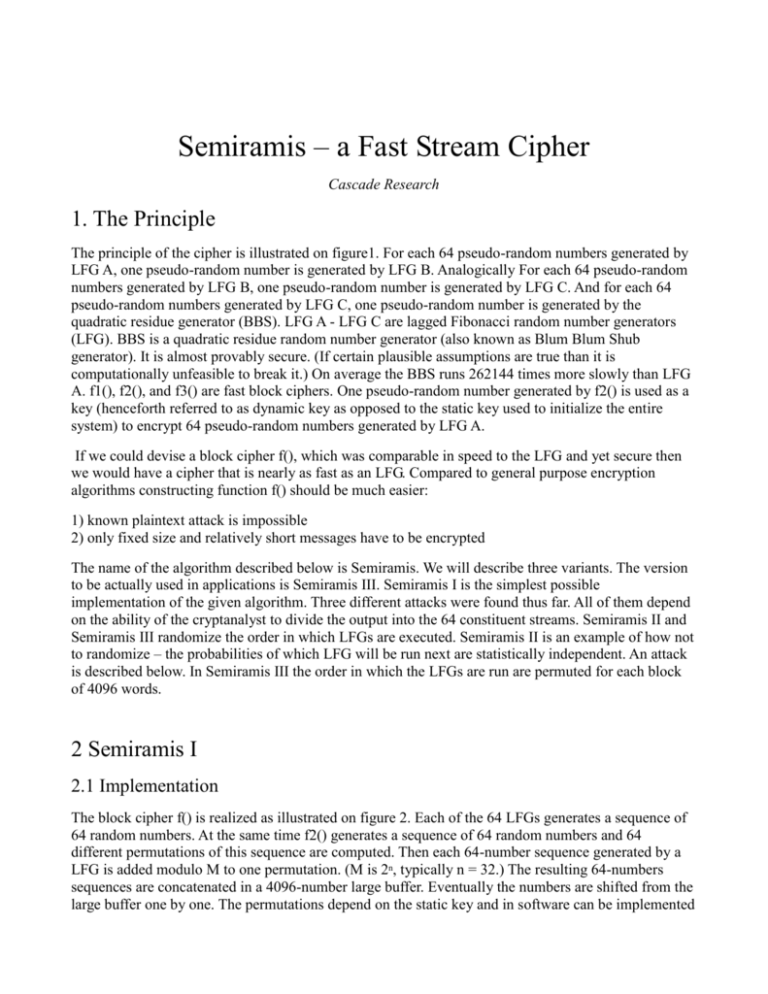
Semiramis – a Fast Stream Cipher
Cascade Research
1. The Principle
The principle of the cipher is illustrated on figure1. For each 64 pseudo-random numbers generated by
LFG A, one pseudo-random number is generated by LFG B. Analogically For each 64 pseudo-random
numbers generated by LFG B, one pseudo-random number is generated by LFG C. And for each 64
pseudo-random numbers generated by LFG C, one pseudo-random number is generated by the
quadratic residue generator (BBS). LFG A - LFG C are lagged Fibonacci random number generators
(LFG). BBS is a quadratic residue random number generator (also known as Blum Blum Shub
generator). It is almost provably secure. (If certain plausible assumptions are true than it is
computationally unfeasible to break it.) On average the BBS runs 262144 times more slowly than LFG
A. f1(), f2(), and f3() are fast block ciphers. One pseudo-random number generated by f2() is used as a
key (henceforth referred to as dynamic key as opposed to the static key used to initialize the entire
system) to encrypt 64 pseudo-random numbers generated by LFG A.
If we could devise a block cipher f(), which was comparable in speed to the LFG and yet secure then
we would have a cipher that is nearly as fast as an LFG. Compared to general purpose encryption
algorithms constructing function f() should be much easier:
1) known plaintext attack is impossible
2) only fixed size and relatively short messages have to be encrypted
The name of the algorithm described below is Semiramis. We will describe three variants. The version
to be actually used in applications is Semiramis III. Semiramis I is the simplest possible
implementation of the given algorithm. Three different attacks were found thus far. All of them depend
on the ability of the cryptanalyst to divide the output into the 64 constituent streams. Semiramis II and
Semiramis III randomize the order in which LFGs are executed. Semiramis II is an example of how not
to randomize – the probabilities of which LFG will be run next are statistically independent. An attack
is described below. In Semiramis III the order in which the LFGs are run are permuted for each block
of 4096 words.
2 Semiramis I
2.1 Implementation
The block cipher f() is realized as illustrated on figure 2. Each of the 64 LFGs generates a sequence of
64 random numbers. At the same time f2() generates a sequence of 64 random numbers and 64
different permutations of this sequence are computed. Then each 64-number sequence generated by a
LFG is added modulo M to one permutation. (M is 2n, typically n = 32.) The resulting 64-numbers
sequences are concatenated in a 4096-number large buffer. Eventually the numbers are shifted from the
large buffer one by one. The permutations depend on the static key and in software can be implemented
as lookup tables.
2.2 Execution speed
The aforementioned scheme has been implemented in C. Its execution time is about 1.5 times that of a
standalone LFG. On 300 MHz Celeron processor it can encrypt 266 Mbits/s of data (excluding disk
access). On a 64-bit machine it will run twice as fast as on 32-bit machine.
2.3 Cryptanalysis - Summary
There are two basic flavors of Semiramis non-randomized and randomized. In the non-randomized
version the cryptanalyst can separate the output into its 64 constituent streams. In the randomized
version the 64 constituent streams are randomly interleaved making it much harder for the cryptanayst
separate one stream from another.
Three different attacks were discovered thus far againts the non-randomized version.
Collision attack exploits the tap equation, namely the fact that
LFG[m][a] + LFG[m][a+24] + LFG[m][a+55]
has a 0 LSBit always, for any m, a. This attack can be defeated by eliminating certain permutations.
Summation attack exploits the fact that the sum of of all the permutations of the 64 pseudo-random
numbers generated by f2() is constant. This attack can be thwarted for example by having f2() generate
128 random numbers, randomly selecting 64 and permuting them.
Decimation attack exploits the fact that any regdular decimation of an LFSR is also an LFSR and that
the XOR combination of the output of two LFSRs of the the same length is the output of another LFSR
of the same length.
A universal method for defeating all three attacks is to randomly interleave the 64 streams. Semiramis
II is an erroneous implementation of randomization. We include that attack below for the sake of
completeness. Semiramis III remains unbroken.
2.4 Cryptanalysis - Detailed Description
Let us denote the sequence generated by LFG i as {Fi} and the dynamic key sequence as {D}, and the
permutations as Pi(). We then generate sequences
{Si} = {Fi} @ Pi{D}
where “@” is either termwise addition modulo M or exclusive or.
The LSB of the stream generated by each of the lagged Fibonacci generators {Fi} will agree with the
LSB of the output sequence {Si} 50% of the time. Therefore correlation attack on the LSB will fail.
If we did not use the permutations and simply “xored” the keystream with the output of each of the
LFGs such that
{Si} = {Fi} ^ D
then the cryptanalyst could simply “xor” two output streams {Si} and {Sj}
{Si} ^ {Sj} = [{Fi} ^ {D}] ^ [{Fj} ^ {D}] = {Fi} ^ {Fj}
and thus factor out {D}. But when the sequence {D} is permuted differently then it is not so simple.
The following two attacks were discovered by Scott Fluhrer.
2.4.1 Collision Attack
Here is how to distinguish this from randomness, given perhaps 10 Megabytes of output.
First, we note that:
LFG[m][a] + LFG[m][a+24] + LFG[m][a+55]
has a 0 LSBit always, for any m, a. This is due to the LFG tap equation.
Second, let us define a "P Collision" as three values (m,n,a) such that the three values (P[m][a],
P[m][a+24], P[m][a+55]) are a permutation of the three values (P[n][a], P[n][a+24], P[n][a+55]) (and
0<=a<9, 0<=m<n<64). For such a collision, let us call those three values (X, Y, Z)
The probability of a particular (m, n, a) set being a "P Collision" is 3! / (64*63*62) = 1/41664. There
are 64*63/2 * 9 = 18144 (possible values of (m,n,a)), and so the probability that at least one "P
Collision" exists within a particular P array is approximately 0.35.
Now, if a P Collision exists, then we note that, examining only the LSBit:
Output[m*64+a] + Output[m*64+a+24] + Output[m*64+a+55] +
Output[n*64+a] + Output[n*64+a+24] + Output[n*64+a+55] =
LFG[m][a] + DynamicKey[P[m][a]] +
LFG[m][a+24] + DynamicKey[P[m][a+24]] +
LFG[m][a+55] + DynamicKey[P[m][a+5]] +
LFG[n][a] + DynamicKey[P[n][a]] +
LFG[n][a+24] + DynamicKey[P[n][a+24]] +
LFG[n][a+55] + DynamicKey[P[n][a+5]] =
(rearranging terms)
LFG[m][a] + LFG[m][a+24] + LFG[m][a+55] +
LFG[n][a] + LFG[n][a+24] + LFG[n][a+55] +
DynamicKey[P[m][a]] + DynamicKey[P[m][a+24]] + DynamicKey[P[m][a+5]] +
DynamicKey[P[n][a]] + DynamicKey[P[n][a+24]] + DynamicKey[P[n][a+5]] =
(substituting in common values due to the P Collision, and using the
commutivity of addition)
LFG[m][a] + LFG[m][a+24] + LFG[m][a+55] +
LFG[n][a] + LFG[n][a+24] + LFG[n][a+55] +
DynamicKey[X] + DynamicKey[Y] + DynamicKey[Z] +
DynamicKey[X] + DynamicKey[Y] + DynamicKey[Z] =
LFG[m][a] + LFG[m][a+24] + LFG[m][a+55] +
LFG[n][a] + LFG[n][a+24] + LFG[n][a+55] +
2*( DynamicKey[X] + DynamicKey[Y] + DynamicKey[Z]) =
(because we're looking only at the LSBit):
LFG[m][a] + LFG[m][a+24] + LFG[m][a+55] +
LFG[n][a] + LFG[n][a+24] + LFG[n][a+55] =
(substituting in our first observation):
0+0=0
Note that we got a zero dependent only on the settings of P -- the actual values of the LFG and the
Dynamic Key were irrelevant.
We further note that the same P array is used 64 times in generating 1 Meg output.
And so, the distinguish becomes:
- For every possible (m, n, a) triplet:
- Compute the lsbit of
Output[m*64+a] + Output[m*64+a+24] + Output[m*64+a+55] +
Output[n*64+a] + Output[n*64+a+24] + Output[n*64+a+55]
for each of the 64 rounds.
- If each of the 64 rounds gives you an lsbit of zero, it's definitely Semiramis (with a 2**-64
probability of a false hit, such can effectively be ignored)
- If no such triplet gives an all-zero output, then we suspect it is not Semiramis.
If we iterate this with 10 successive 1 Meg blocks, then the probability that Semiramis not being
detected 10 times in a row is about 0.013, which is certainly small enough that we can claim to have a
distinguisher with only 10 MBytes of output (and using far stronger criteria than is normally used).
This attack can be generalized by defining a "P Collision" as three values (m, n, a, b) such that the three
values (P[m][a], P[m][a+24], P[m][a+55]) are a permutation of the three values (P[n][b], P[n][b+24],
P[n][b+55]). Then for the LSB we obtain
LFG[m][a] + DynamicKey[P[m][a]] +
LFG[m][a+24] + DynamicKey[P[m][a+24]] +
LFG[m][a+55] + DynamicKey[P[m][a+5]] +
LFG[n][b] + DynamicKey[P[n][b]] +
LFG[n][b+24] + DynamicKey[P[n][b+24]] +
LFG[n][b+55] + DynamicKey[P[n][b+5]] = 0
The attack can be executed analogically to the special case although it requires a lot more memory.
2.4.2 Summation Attack
To repeat the encryption description (slightly modified to make the attack clearer):
To generate the keystream:
For z = 0 to 64 (NumDynamicKey) - 1
For m = 0 to 64 (NumGenerators) - 1
For i = 0 to 64 (Generator size) - 1
Output[z*4096+m*64 + i] = LFG[m][z*64+i] + DynamicKey[z,P[m][i]]
endfor
endfor
endfor
In the above description, I change the meaning of DynamicKey to be a two dimensional array, instead
of updating the single DynamicKey array each 4k of output.
We first note that, for any fixed x, LFG[m][x] can be expressed as a linear combination of LFG[m][0],
..., LFG[m][54], and the constant terms depend only on x, and not the LFG contents.
We also note that P[m] is a permutation of the integers 0 through 63.
Now, consider the sum (for fixed m, z):
Sum Output[z*4096+m*64+i]
0<=i<64
We note that this m is computable given the output stream. This sum is equal to:
Sum LFG[m][z*64+i] + DynamicKey[z,P[m][i]]
0<=i<64
We note that the first term is equal to some (easily computed) linear combination of LFG[m][0], ...,
LFG[m][54], and the sum of 64 such linear equations is another linear equation C_(m,z,0) * LFG[m][0]
+ ... + C_(m,z,54) * LFG[m][54] (for some fixed C_(m,z,i))
We note that, since P[m][i] is a permutation of 0 through 63. By the commutativity of addition, we can
rearrange those elements in order, and hence the sum of the second term becomes:
Sum DynamicKey[z,i]
0<=i<64
We will denote such a sum as D[z]
And hence, the original sum is equal to the following linear equation on the unknowns D[z] and
LFG[m][i]:
D[z] + Sum C_(m,z,i) * LFG[m][i]
0<=i<55
Now, with 917504 bytes of output, we have 56 distinct z's and 64 distinct m's. This gives us 3584
linear equations. In addition, there are 56 D[z] unknowns and 64*55 = 3520 LFG[m][i] unknowns.
Hence, there are a total of 3576 unknowns, and so we should be able to solve this uniquely, giving us
the entire LFG state in a reasonable period of time.
Once we have the LFG state, re-deriving the contents of the P[m] permutation and the DynamicKey
array is straightforward, giving us the entire cipher state (up to a single permutation onto P and the
corresponding inverse permutation on DynamicKey) with a little less than 1Meg of output.
2.4.3 Decimation Attack
This attack was discovered by Gregory Rose.
First, note that the LSB of a Lagged Fibonacci generator is also an LFSR, with the same feedback
polynomial as the LFG. In this case that's a trinomial.
Second, any regular decimation of an LFSR is also an LFSR, with an easily calculated polynomial.
Third, note that the combination operation "added modulo 2^n" is the same as XOR for the LSB.
Fourth, note that the XOR combination of the output of two LFSRs of the the same length is the output
of another LFSR of the same length.
So, we will examine just one of the 64 LFGs, and on just one of its output bits, and even then on just
one of its 64 output words, at a time. Eg. the first output word from each group corresponds to a
particular one of the 64 input words from f2().
The attack proceeds by first gathering 110 lots of 4096-word output buffers (call it 60K words)
Now, there are 4096 words per buffer load, being combined from a particular 64-word f2()-block,
effectively at random. Take a particular word from the 64 generated by combination with F1. For each
of 64 words generated by one of the other 63 registers, there's a 1/64 probability that it was combined
with the same word from f2(). We XOR them (removing the f2 influence) and discard all but the LSB.
Now we have 110 bits (from the 110 input blocks), which, if we are lucky, (P=1/64) will be the output
from an LFSR. We feed them to the Berlekamp-Massey algorithm to find out. 110 bits is enough, with
overwhelming probability, to spot the ones that have a register length of 55 from the ones where the
f2()-words didn't correspond. (Note also that B-M is quite fast...)
Every time we identify a match with an f2()-word, we have effectively found a set of 55 linear
equations in 110 variables (those being the LSBs of the two LFGs involved in the match). Note that
only 55 equations result, because the rest will be linearly dependent on those 55. Since there are a total
of 64*55=3520 LSBs in those registers, we need to get lucky 32 times. For each word we choose, there
are expected to be 64*63/64 matches in the other words.
Note that we have also identified lots of information about the "secret" select-and-permute tables.
3 Semiramis II
All the three attacks described above relied on the ability of the cryptanalyst to break down the output
stream into its 64 constituent streams. The 64 LFGs were executed one by one in a known order for a
fixed number of steps each. In Semiramis II the streams are desynchronized. They are executed in a
random order and for a random number of steps. Here is the pseudocode.
For z = 0 to 64 (NumDynamicKey) - 1
m = random number <0, 63>
if (index of LFG(m) = 0) then
run length = 17 + random number <0, 32
else
run length = 64 - 1
For i = 0 to run length
Output[z*4096+m*64 + i] = LFG[m][z*64+i] + DynamicKey[z,P[m][i]]
endfor
endfor
m is not autoincremented but selected randomly. The run length is randomply selected in the interval
<17, 48>. Therefore each run is shorter than 55 steps.
This is a flawed implementation. Note that the random numbers mz are statistically independent. This
means that more than 64 words of a given LFGq can be used in a block of 4096 words i.e. an LFG will
use several words of the dynamic key more than once. This weakness can be exploited by the attack
described below. The author is Leslie McBride.
3.1 Attack
To form a known plaintext attack we need a special block. One in which one LFG is repeated 3
consecutive times. This occurs on average once ever 64^3/64 times (every 4096 blocks). Since the
Dynamic key bits don't change and neither do the Permutations we can guess a fixed 64 bit value for
the lowest bits of the key for this block. The ordering in the original dynamic key isn't important only
how they are used in that block. We will call this a virtual key. Then using the known plaintext we can
determine the state of the lowest bits of that LFG. We can tell when the dynamic key is correct because
the last run will calculate from the previous runs. Because of the way the LFGs are used three runs are
guaranteed to be 64 bytes plus at least 17 bytes.
Each subsequent bit of that LFG can be determined in a similar manner. Knowing the lower bits helps
calculating likely values for the guess of the higher bits of the virtual key for that block. The carries in
addition actually make this easier. Guessing the second set of 64 bits is independent of guessing the
first set of bits and easier. The two guesses take less than 2^65 operations compared to the 2^128
operations that would be required if they couldn't be separated. This can be guessed up the chain of bits
in the words. The total cost is less than 2^96 operations. If xor was used instead of addition in
calculations it would be exactly 2^96.
Alternatively we could guess the LFG bits and determine the virtual key bits. This reduces the guessing
difficulty to 2^55. But the explanation isn't as straight forward. Again we can work up the bits. We can
reduce this even further by guessing only specific subsets of bits at a time.
Since we now know the complete virtual key we know all of the words used in the dynamic key. We
can scan the remainder of the block for any additional uses of the LFG. This will give us good starting
points for the next step. Additionally we can scan other blocks of known plaintext preceding or
following this one for this LFG giving us the virtual keys of those blocks.
Since we now know the dynamic key words, the number of 1 and zero bits is given which can greatly
reduce the cost of guessing. This cost will depend on the actual value of the dynamic key lower bits. If
all of the dynamic key lower bits are zero for example, the cost of the next guess is 0. With one bit set
to one and the rest zero the cost is 2^6. The worst case with half the bits set is 2^21.
We repeat the guessing procedure for the next LFG. This can be done in any block which we can
determine a virtual key for. We guess a length and two starting positions. The length is a 2^6 operation
and the two starting positions are less than 2^12 operations. This costs us a maximum of 2^30. Next we
guess bits, this brings the total cost to 2^51. We can slide this guess across this block looking for
matches for verification. This difficulty is about 2^10. If we find a partial match then we can change
guesses for a subset of bits. This sliding technique can also be used to eliminate the need for three
consecutive runs at the start. Meaning one in 64 blocks will be satisfactory for breaking the cipher.
Partial matches will also reduce the search complexity. The next layer of bits will be easier since the
position is now certain. This search is no more than 2^21 in difficulty. It should be considerably easier
since we now have the lower two bits in place. The final positioning of the words in place has a
difficulty of about 2^18. This also gives a permutation relation of the two permutations. Additional
LFGs used at least three times in this starting block can be found. These can be used to find other LFGs
in other blocks. Once all LFGs in the lowest layer are known other blocks with unknown text can be
broken by statistical analysis. This attack does not depend on finding the actual dynamic keys or
permutations. Only the words the dynamic keys are composed of and the relation between the
permutations in the lower layers. Additionally it can be extended to use fewer blocks of known text and
the known text does not have to be contiguous.
4 Semiramis III
This is a randomized version of Semiramis I. The difference between Semiramis II and Semiramis III is
that that the random numbers mz are not statistically independent. Each LFG is run exactly 64 steps in
each block of 4096 words. The random numbers needed for m and the run length are acquired from the
layer above. The Semiramis algorithm encrypts LFG streams. Desynchronizing the 64 streams adds the
transposition element to the substitution element. Thus far this implementation is unbroken.
